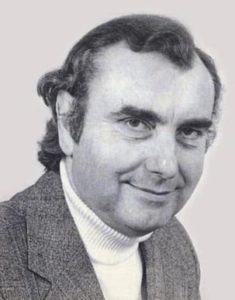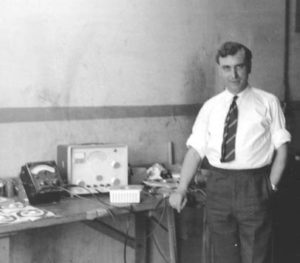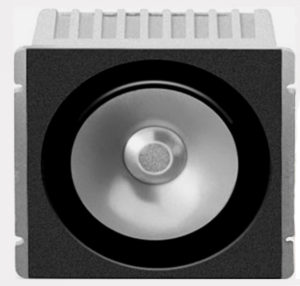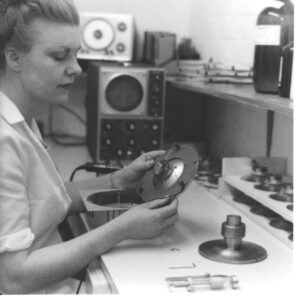The earliest photograph of Edward James Jordan (Ted to everybody who knew him) was taken in 1931 and shows him sitting on his father’s knee. Ted is wearing headphones and adjusting a crystal radio set, one of the earliest types of receiver. With his mother coming from a musical family and his father a skilled amateur radio builder, Ted was genetically predisposed for his future career.
After college, Ted joined GEC as an assistant in the radio laboratories. His first hi-fi experience was hearing a full concert orchestra played through an array of GEC 8 metal-coned loudspeakers recently developed by Head of Research, Hugh Brittain. This was the closest approach to live concert sound he had heard. Ted acquired a pair of these drivers and designed a double transmission line enclosure. This was the subject of Ted’s first article commissioned by The Journal of The British Sound Recording Association in 1951.
In 1952 Ted joined Goodmans Industries, which at the time had one of the most advanced electro-acoustic laboratories in Europe. Here, he studied every known form of loudspeaker loading and developed new ideas and commenced his seminal studies of cone behaviour. This work resulted in the Goodmans Axiette, a 200 mm driver which was the first of the single cone, truly full-range drivers. Ted subsequently redesigned the entire range of Goodmans drive units and a prototype electrostatic loudspeaker, which exhibited at the London Hi-Fi Show in 1956.
In 1963 Ted’s extensive knowledge and experience was brought together in his definitive textbook, Loudspeakers, published by Focal Press. It included first principle derivation of all loudspeaker parameters (now usually referred to as Theile-Small parameters) and became the industry bible. Throughout his career, Ted was regularly published in the technical press and was always generous with his knowledge.
Around this time Ted, together with Goodmans export manager, Lesley Watts, left the company to form Jordan-Watts and develop the famous Jordan-Watts Module. This was an advanced, alloy cone, full-range driver, arguably several decades ahead of its time. It sold successfully around the world for many years, until the company closed in 1978. Second-hand samples are still in demand today, especially in the Far East.
In the mid-1960s, Ted left Jordan-Watts to start his own consultancy, working on a diverse range of projects. One collaboration was with John Wright (later of IMF Loudspeakers) of the Audio & Design company, to develop a full-range titanium cone drive unit, which later went on to be marketed by Keesonic, QED and Keith Monks.
In 1982, EJ Jordan Designs was formed to develop, manufacture and market Ted’s own products, the first of which was the 50mm Module. This unique, alloy-cone driver covered the mid and treble ranges, requiring only a bass unit to cover the full musical range, an idea which the mainstream hi-fi industry is only now beginning to appreciate.
A range of Jordan loudspeaker drive units followed, including the JX125 and JX150 bass units and the JX92, Ted’s famous full-range driver. These drivers appeared in many high-end loudspeaker systems, including those from Elite Townshend, Electrofluidics in the UK, Sequerra in the USA, Credo in Switzerland and a revitalised Jordan-Watts company. Around this time, Ted developed a novel class A/B power amplifier and matching preamp, second-hand examples of which are highly sought after today.
Ted has collaborated with a number of companies, some of which continue to follow his ideas. After a brief flirtation with retirement – and dissatisfied with how his licensed designs were being developed – he picked up the measuring microphone and re-entered the market with a new Jordan full-range drive unit, the Eikona, manufactured entirely in the UK. This proved highly popular; so much so that demand outstripped supply. A mark 2 version was developed, with added refinements, and assembly was undertaken by Scan-Speak. This re-established Ted’s long term connections with the Danish loudspeaker industry.
Ted’s innovative legacy continues to this day through the company that bears his name and he left new ideas and designs to be developed over coming years.
“Edward James Jordan probably knows more about cone drivers than any other living person, having devoted a lifetime to their design and manufacture.”
David Manley, The Vacuum Tube Logic Book





